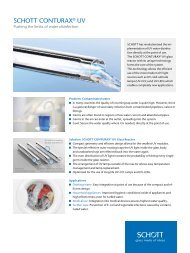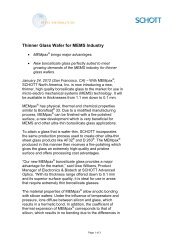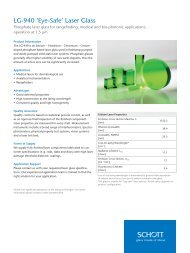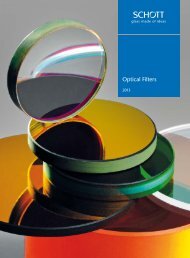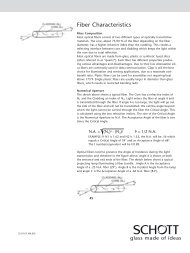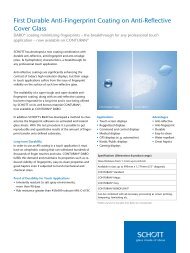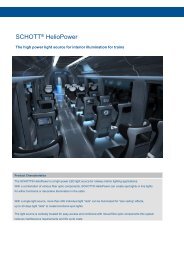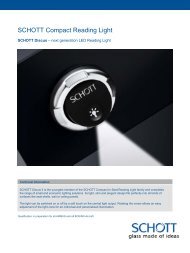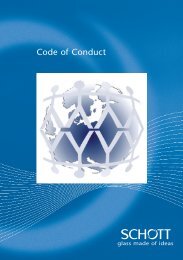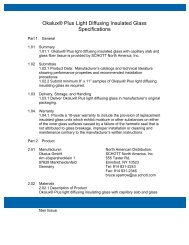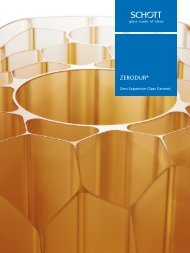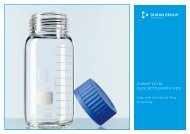Machine Vision Illumination Catalog, Vol 001
Machine Vision Illumination Catalog, Vol 001
Machine Vision Illumination Catalog, Vol 001
You also want an ePaper? Increase the reach of your titles
YUMPU automatically turns print PDFs into web optimized ePapers that Google loves.
The calculated minimum NA. required for the 45° Angle of Incidence is<br />
.38. Therefore, a fiber with an NA. of .66 will accept all of the light<br />
from the lamp, but the output angle will only be 45° and not the 83°<br />
which might be expected. However, the .25 NA. fiber which cannot<br />
accept all of the light, will have an output angle of 20°. Using a low NA.<br />
fiber will not focus the light from a lamp because it can’t receive any<br />
light beyond its Critical Angle and therefore has a narrow output cone.<br />
Multicomponent glass fibers typically reach NA values up to 0.9,<br />
whereas quartz silica fibers typically do not exceed 0.4 NA values.<br />
Transmission Characteristics of Optical Fibers<br />
High quality optical glass (crown and flint glass) is used for the light<br />
transmitting core and an optical glass with a different refractive index<br />
for the cladding. Wavelengths between 400 and 900 nm are<br />
transmitted uniformly, with only minor variations.<br />
In this range SCHOTT's standard multicomponent glass fibers (A2, B3)<br />
have attenuation levels between 150 and 300 dB/km. Transmission in<br />
the UV range is very low and wavelengths below 350 nm are not<br />
transmitted. However, the near infrared range (0.8 μm to 1.3 μm) is<br />
transmitted very well by glass fibers. At 1.4 micron, all fibers except<br />
those specifically designed for IR transmission, show a significant drop<br />
in transmission due to OH-Absorption within the glass. In the range<br />
from 1.4 up to 2.0 μm specifically designed glass fibers for IRtransmission<br />
can be used.<br />
For improved transmission over the entire range from 250 nm up to 3.0<br />
μm quartz (fused silica) fibers are the best choice, but have a lower NA.<br />
Fiber Characteristics<br />
Transmission Characteristics of Optical Fiber Bundles<br />
Although specific information on the performance of a single fiber is<br />
valuable, it is important to understand how optical fibers perform when<br />
manufactured into bundles. Due to total reflection, a portion of the<br />
light will be reflected at the polished glass surface of the fiber at the<br />
entrance as well as the exit. In addition, the interstitial gaps between<br />
the fibers, usually filled with epoxy glue, will not transmit any light. The<br />
losses due to these two effects can be estimated at appoximately 25 %<br />
-30 %, depending on the polishing quality. The loss of the interstitial<br />
gaps can be reduced by hotfusing the entrance end instead of glueing<br />
the fibers together. Thus, transmission can be increased up to 15 %. In<br />
addition, transmission loss will be caused with increasing length of the<br />
lightguide. A 3-foot/1m lightguide will transmit approximately 60% of<br />
the light emitted by the lamp towards the fiber bundle within the NA.<br />
A 10-foot/3m light guide will transmit about 55% of the light and a<br />
30-foot/10 meter lightguide roughly of 40 %.<br />
i-197



